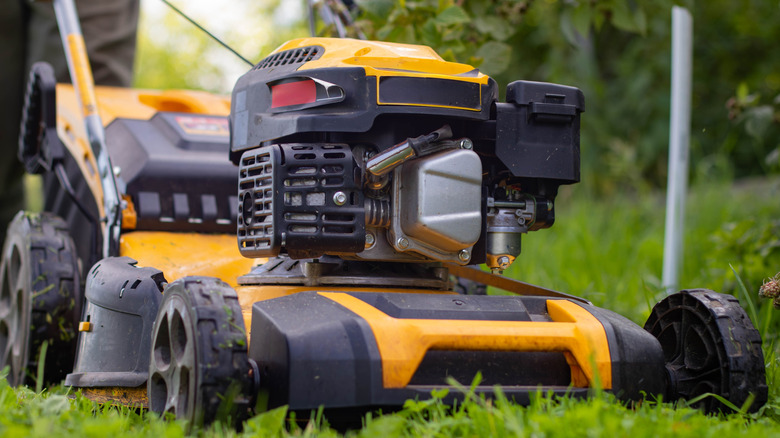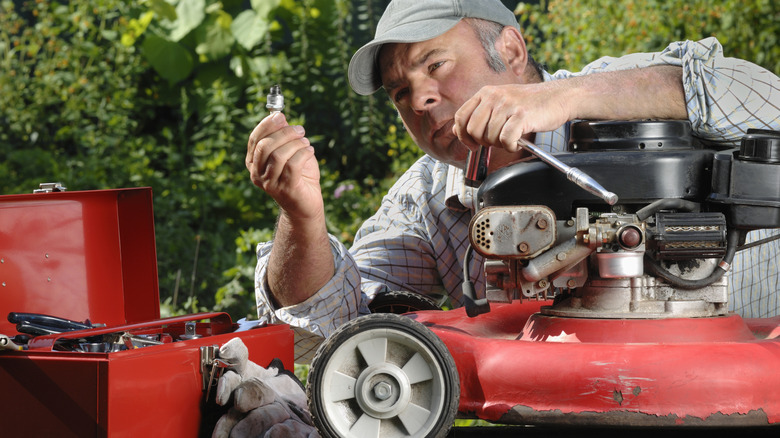Why Your Lawn Mower Won't Turn Off (And How To Safely Fix It)
Your lawn mower has done its job, and the grass looks great. But when you let go of the handle, nothing happens. The engine keeps roaring. Surprisingly, it happens more often than you'd think. While it might feel like your machine has developed a mind of its own, the explanation is usually mechanical. One common culprit is a switch tab that fails to press into the control bracket upon releasing the handle. It could also be a faulty ignition switch or a wiring issue that's keeping the circuit open. In some cases, the engine brake might be failing to do its job. Thankfully, though, most of these issues can be tackled with a good fix, adjustment, or part replacement.
Before you start tugging at cables or pulling off parts, it's worth stepping back and assessing the situation. Not all mower malfunctions are created equal. Some problems are annoyingly simple, like debris blocking a switch, while others are signals of deeper wear and tear. Whether you've got a lean electric lawn mower or a gas-powered beast, understanding what's supposed to happen when you shut it down gives you the best shot at figuring out why it didn't.
Common reasons your lawn mower won't turn off
It's best to start your investigation with the handle. The moment you let go, the mower should stop humming. One of the most overlooked reasons why it wouldn't is that the stop switch tab doesn't quite meet the control bracket. These two parts are supposed to touch and signal the engine to cut off. But if your mower's been through a rough patch, maybe it hit a tree root or just got jostled around in storage, they might've shifted slightly. And when that contact fails, your engine keeps running.
Then there's the ignition switch. Flip it, and it should instantly break the circuit and stop the engine. But if that switch is worn down, it might not register your command. Closely tied to this is the control cable, which is the link between the handle and the switch itself. If the cable is frayed, rusted, or stretched out, it may not release the switch like it's supposed to. This means your engine keeps running, unaware that you've already walked away.
Further, the engine brake, designed to stop the crankshaft when you let go, is another suspect. A jammed or faulty brake can let the engine coast endlessly. You shouldn't underestimate the effects of a dirty air filter either. In rare cases, it messes with airflow enough to confuse engine behavior altogether, even in some of the most popular lawn mower brands.
Safe fixes for a lawn mower that won't shut down
If you suspect the switch stop is causing your lawn mower trouble, remove the protective engine shroud, locate the stop tab, and carefully bend it down with a screwdriver until it meets the bracket again. It's a simple tweak that can bring your mower back in line without breaking a sweat.
If the issue lies with the ignition switch, it's time to test it. A multimeter is your best friend for this test, and even those new to DIY can master appliance repair using one. With the bail in the "off" position, the switch should show continuity. If there is no reading, that switch is toast. Luckily, swapping it out is usually painless. Remove the engine cover if needed, unplug the wires (snap a pic first if you're nervous), unscrew the faulty switch, and screw in the new one. Make sure everything fits snugly so the actuator presses firmly against the switch.
If all else fails and your mower still refuses to quiet down, you've got some backup moves. You can wire in a kill switch, which is an easy DIY add-on that gives you instant shutoff control. Or, in a pinch, just disconnect the spark plug wire while wearing gloves to prevent an electric shock. If all else fails, carefully apply a full choke by removing the air filter and covering the carburetor with a rag to restrict the air flow and stall the engine. It's not elegant, but it gets the job done when nothing else will.


